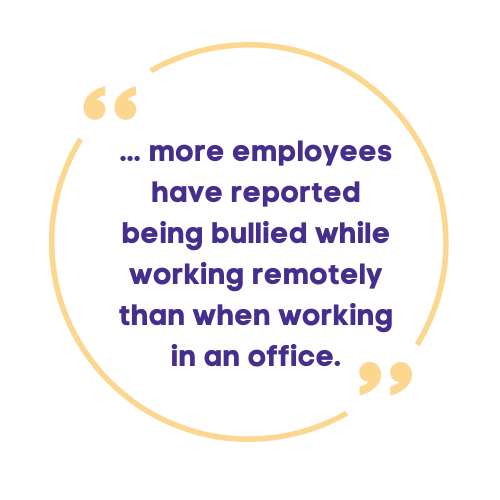Addressing Behavior That Is Problematic But not Illegal
[This article originally appeared in the November 2021 issue of HR News, the magazine of the International Public Management Association for Human Resources.]
Much has been written about the emotional toll and adverse financial effects of workplace bullying. Not only is the target of the bullying affected, but witnesses are also negatively impacted. The results can be decreased productivity, increased employee turnover, and difficulty recruiting skilled candidates. For this reason, employers have a significant interest in preventing and responding to bullying behavior in the workplace.
What Constitutes Bullying?
The California, where we practice as attorneys, a state law (AB-2053) defines “abusive conduct,” which is also known as bullying, as “conduct of an employer or employee in the workplace, with malice, that a reasonable person would find hostile, offensive, and unrelated to an employer’s legitimate business interests.” The law further clarifies, “Abusive conduct may include repeated infliction of verbal abuse, such as the use of remarks, insults, and epithets, verbal or physical conduct that a reasonable person would find threatening, intimidating, or humiliating, or the gratuitous sabotage or undermining of a person’s work performance. A single act shall not constitute abusive conduct, unless especially severe and egregious.”
 Studies conducted by the Workplace Bullying Institute indicate that most bullies are in management, but peers also bully each other. Sometimes, subordinates bully their supervisors.
Studies conducted by the Workplace Bullying Institute indicate that most bullies are in management, but peers also bully each other. Sometimes, subordinates bully their supervisors.
Regardless of the dynamic, 30 percent of adult Americans reported being bullied at work. In addition, while many expected that the COVID-19 pandemic and the pivot to remote work it prompted would reduce workplace bullying due to lack of opportunity, more employees have reported being bullied while working remotely than when working in an office.
To reduce and prevent workplace bullying in an organization, bullying must be defined and condemned, complaints of bullying must be investigated promptly and seriously, and every employee must take part in creating a better organizational culture. Some changes can be made in advance of a problem, specifically through anti-bullying policies, training, and changing incentives. For instance, incentives that promote aggressive behavior might lead to more bullying. Conversely, requiring collaborative communication on performance evaluations might lead to less.
What Should Anti-Bullying Policies Address?
An anti-bullying or healthy workplace policy should
- Define prohibited conduct,
- Address online communications,
- Prohibit retaliation against employees who bring complaints or participate in workplace investigations, and
- Offer assurances that complaints will be investigated and violators will face consequences.
The policy should clarify that it addresses conduct at worksites and during online interactions between employees. Explanations for the prevalence of reports of online bullying include the facts that people tend to act less formally in a virtual environment, there are fewer bystanders and the platforms being used are often unmonitored. When it comes to written messages, the inability to convey tone may also exacerbate existing communication issues.
The policy should also address retaliation because fearing reprisal is one of the main reasons employees are hesitant to raise concerns. This fear is not entirely unfounded. We are often called upon to investigate allegations of retaliatory behavior, and it is not uncommon to find that retaliation occurred even when the original complaint was not substantiated.
Another reason employees are hesitant to report concerns is because they believe doing so will not accomplish anything. For this reason, it is important that employee complaints are addressed promptly and seriously. Even anonymous complaints should be pursued when there is sufficient information to investigate.
If the reported behavior is dismissed, or there is a perception that no prompt action was taken, employees will cease to bring issues to management’s attention. Unreported bullying might lead to greater issues down the road, such as high employee turnover and difficulty filling open positions.
Do Prevention Tools Other Than Policies Exist?
Empowering fellow employees to intervene can also prevent bullying. For instance, an employee could help the bullied target escape the situation by asking to speak to them about something, using humor to defuse the situation, distracting the bully, confronting the bully directly about their unfair treatment, or, at minimum, reporting the incident to management.
To intervene, an employee needs to
- Notice an incident occurring,
- Recognize the incident as an emergency requiring intervention,
- Assume personal responsibility to help, and
- Feel they can competently intervene.
Offering bystander intervention training can help employees develop the listed skills and become comfortable being an upstander who steps in to end bullying. This type of training teaches employees what bullying looks like so they can recognize it. The training also encourages employees to see themselves as responsible for their workplace. Absent this type of specialized training, employees should, at a minimum, be informed of the bullying policy and told to whom they can report incidents.
For managers, specific training and coaching on treating employees with respect, being inclusive and demonstrating empathy may also help prevent instances of bullying. Empathy can be demonstrated by acknowledging employees’ thoughts and feelings without dismissing them and by recognizing that employees need encouragement and support. Providing managers with specific techniques such as active listening (e.g., repeating what employees say so they feel heard) and helping them answer employee questions satisfactorily, give and receive negative feedback, and express appreciation to employees can encourage the development of a healthier and more collegial workplace.
How Should Workplace Bullying Be Investigated?
When an employee comes forward and reports experiencing or witnessing workplace bullying, an investigation should be initiated promptly to determine what occurred and whether the behavior constitutes a policy violation. This type of investigation will typically involve interviews with the complainant and the accused, as well as interviews with other employees who may have witnessed the conduct or who can offer insight into the respondent’s (i.e., the accused bully’s) behavior. These other interviewees could include the respondent’s peers, direct reports or supervisor. The investigation may also involve a review of documents, particularly when online bullying is reported.
Taking interim measures is sometimes necessary during an investigation to ensure the well-being of the employees and the integrity of the investigation, especially if retaliation is a concern. For instance, if the accused bully is a manager, can the complainant temporarily report to someone else while the investigation is ongoing? Employees should be consulted before any such action is taken.
The investigator should be ready to look into a long list of incidents because it often takes some time before an employee feels ready to file a complaint. Helpful questions to ask the complainant include
- What is the first incident you remember?
- What is the most recent incident?” and,
- What is the worst incident?
The investigator should also ask how frequently the conduct occurred.
In general, the investigator should attempt to quantify subjective behavior by asking follow-up questions. An example of this would be asking a complainant who said the accused “yelled” at them to rate the volume of accused’s voice on a numerical scale.
It is likewise important to ask for specific examples of “demeaning comments,” of body language when someone was “mad,” of the estimated distance when someone was “close,” and so on. While this is not an exact science, obtaining such ratings from witnesses allows an investigator to compare differing accounts more easily.
With respect to interviewing the respondent, it is common for employees accused of bullying to understate or deny their behavior. Still, each employee should be given the opportunity to explain their actions, provide additional context and deny specific allegations. It is always possible that things have been misunderstood or taken out of context.
The investigator should ask both the target of bullying and the accused bully for information that could corroborate their versions of events. Initial questions to ask here include whether others witnessed the conduct, if anyone else was treated similarly and whether the complainant spoke with anyone about their concerns. Documentary evidence could include notes the employee took, emails and text messages.
Investigations will proceed most productively when employers include suggestions to contemporaneously document concerning behavior and to save or screenshot upsetting message in trainings on bullying. Especially in situations with no witnesses, contemporaneous notes and saved communications are helpful in determining which version of events is more credible.
Certain situations are best handled by neutral third-party investigators. For instance, if a high-level executive is accused of bullying, it may be proper to hire an external investigator who can remain impartial. Otherwise, there is a chance abusive behavior might be excused.
Similarly, if it is suspected that the culture in a workgroup promotes bullying, conducting an anonymous survey through a third party allows employees to speak freely about issues. Employees who are assured of anonymity may be more honest about whether bullies are peers or managers, how frequently bullying occurs, how it occurs and whether employees feel they can report issues to management.
If an investigation finds that bullying occurred, coaching the bully is one potential option. Bullying may be driven by a lack of self-control, aggression being rewarded, being unaware of one’s impact, a reaction to threats towards one’s self-esteem, or the inability to effectively deal with stress at work. If a bully is receptive to coaching, addressing the causes of the abusive behavior may help. In all instances, and so they take the coaching seriously, a bully should be informed of the potential consequences of not changing their behavior.
By creating a policy, setting expectations and effectively investigating issues, bullying can be reduced.
|
|




